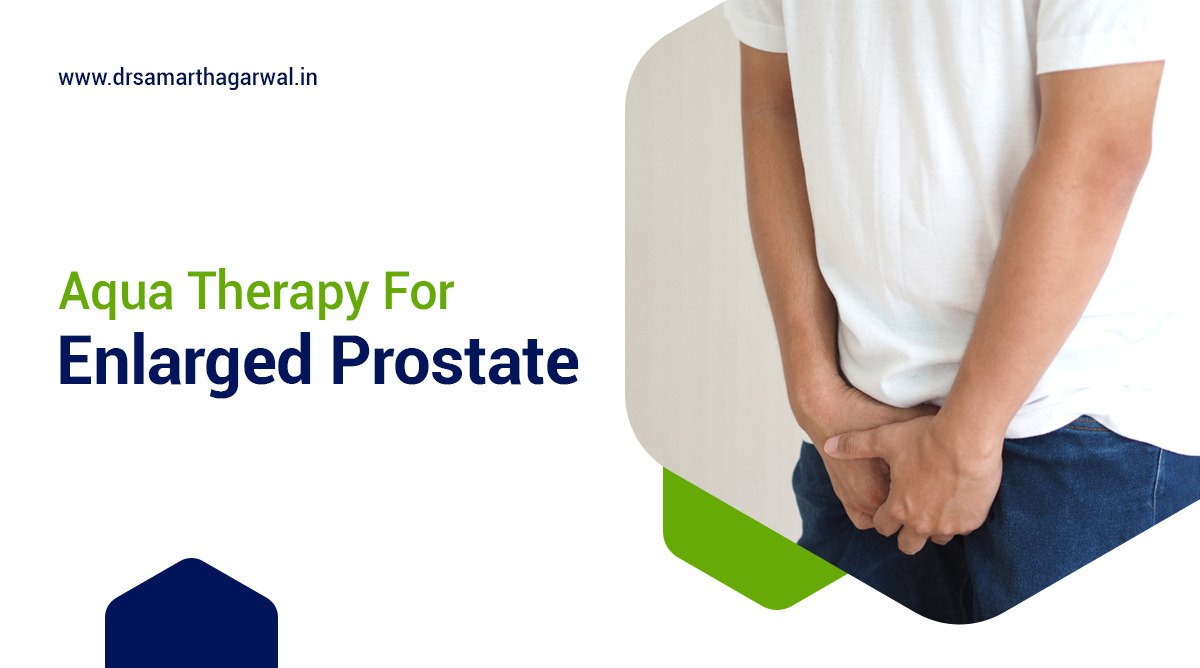Aqua therapy for enlarged prostate involves the use of a minimally invasive surgical procedure called Aquablation to treat symptoms associated with benign prostatic hyperplasia (BPH). During Aquablation, targeted water jets precisely remove excess prostate tissue, offering relief from urinary symptoms.
Research indicates that Aquablation is an effective and safe treatment option for BPH, with studies demonstrating sustained outcomes and few irreversible complications over multiple years of follow-up. The therapy provides a promising alternative to traditional surgical methods for managing BPH symptoms, offering patients improved quality of life and reduced risks of adverse effects.
What is Aqua Therapy for Enlarged Prostate?
Aqua Therapy for Enlarged Prostate, also known as Aquablation Therapy, is an advanced, minimally invasive procedure that utilizes the precision of robotic technology to remove excess prostate tissue using a high-pressure water jet. It’s designed to provide long-lasting relief from lower urinary tract symptoms (LUTS) caused by benign prostatic hyperplasia (BPH) without compromising the patient’s overall health and well-being.
The procedure is performed under anesthesia in a hospital setting and typically requires less than an hour, with most patients needing only one night of hospital monitoring post-operation.
Aquablation Therapy offers several advantages, including its efficacy in treating moderate to severe BPH symptoms, its suitability for patients whose medications have failed or who can no longer urinate without a catheter, and its ability to address other complications of BPH, such as kidney failure, infections, bleeding, and stones.
Aquablation Therapy stands out among BPH treatment options due to its incision-less nature, precise removal of prostate tissue, and minimal invasiveness compared to traditional surgical interventions. While other minimally invasive procedures exist, such as office-based minimally invasive surgical treatments (MISTs), Aquablation Therapy is often recommended for patients with more severe symptoms or larger prostates.
The recovery period after Aquablation Therapy is relatively short, with most men requiring only one night of hospital monitoring and catheter use before returning home catheter-free. Overall, Aquablation Therapy offers a promising solution for individuals seeking lasting relief from the bothersome symptoms of BPH while minimizing the risks associated with traditional surgical approaches.
How Long Does Prostate Aquablation Last?
Prostate Aquablation offers long-term relief from BPH symptoms, with benefits lasting several years post-procedure. The efficacy of Aquablation is supported by studies showing significant improvements in International Prostate Symptom Score (IPSS) data up to five years after treatment, with IPSS improving by 15.1 points. Additionally, most patients experience mild side effects that typically resolve within 1-2 weeks, ensuring a favorable treatment experience.
What Are the Disadvantages of Aquablation?
Based on the provided context, here are the key disadvantages of Aquablation therapy for treating benign prostatic hyperplasia (BPH):
- Potential higher re-treatment rate in the long term compared to techniques like holmium laser enucleation of the prostate (HoLEP), as Aquablation may preserve more prostate tissue.
- Requires catheterization with irrigation for a period after the procedure, as it does not employ heat energy to stop bleeding from the prostate.
- May not be suitable for all patients with certain medical conditions or prostate anatomies.
- Short-term side effects can include mild pain, difficulty urinating, pelvic discomfort, and blood in the urine for 1-2 weeks after the procedure.
- Decreased semen volume is a potential side effect.
- While the risk of long-term sexual dysfunction or urinary incontinence is low, these side effects are still possible.
Overall, while Aquablation aims to be a minimally invasive option for BPH treatment with advantages like reduced procedure time and preservation of sexual function, it may have some trade-offs in terms of re-treatment rates, catheterization requirements, and short-term side effects compared to other surgical techniques.
What Is the Success Rate of Aquablation?
Aquablation therapy has been studied in nine different clinical trials, demonstrating a high success rate. Results indicate its safety and efficacy, with studies consistently reporting positive outcomes. For instance, in long-term follow-ups, approximately 95% of patients still experience favorable results five years post-surgery, highlighting the enduring effectiveness of Aquablation therapy in managing lower urinary tract symptoms due to benign prostatic hyperplasia (BPH).
Below are some studies that were done to understand the success rate of aquablation:
- According to Gilling, Peter, et al’s 2019 study ‘Two-Year Outcomes After Aquablation Compared to TURP: Efficacy and Ejaculatory Improvements Sustained’, the ejaculatory dysfunction rate was significantly lower with Aquablation (7%) compared to TURP (25%) at 2 years.
- According to a 2023 paper published in Urology by Claire S Burton, Amy D Dobberfuhl, and Craig V Comiter: The authors concluded that Aquablation is an effective treatment for men with urinary retention, with 98% achieving spontaneous voiding regardless of preoperative urodynamic findings. Men in acute retention were more likely to fail their initial void trial, supporting a recommendation for a delayed trial without a catheter.
Does Aquablation Need to Be Repeated?
Aquablation may require repeat procedures in some cases. Studies suggest that the risk of needing a repeat procedure with Aquablation is comparable to other surgical methods for treating benign prostatic hyperplasia (BPH). While the majority of patients do not require repeat treatment, a small percentage may undergo a second procedure due to persistent symptoms or complications. Close monitoring and consultation with a urologist are essential for determining the need for additional interventions.
Can Prostate Grow Back After Aquablation?
Yes, prostate tissue can regrow over time after Aquablation. While Aquablation provides significant relief from symptoms of benign prostatic hyperplasia (BPH), it may not offer a permanent solution. Regular follow-ups with a healthcare provider are essential to monitor prostate size and symptom progression. Despite the potential for regrowth, Aquablation remains a durable treatment option with low risk of sexual side effects compared to traditional prostate surgeries.
How Does Aquablation Therapy Compare to Other Bph Treatment Options?
Compared to other BPH treatment options, Aquablation therapy has equivalent surgical success and significantly fewer sexual side effects, making it a promising solution for BPH patients. Aquablation therapy is effective in patients with prostates of varying sizes (30-150 cm³), with low complication and retreatment rates up to 2 years of follow-up.
Aquablation therapy offers several advantages over traditional surgical treatments for benign prostatic hyperplasia (BPH):
- Minimally Invasive: Aquablation is a minimally invasive procedure that typically requires no incisions, reducing the risk of complications compared to traditional open surgeries.
- Preservation of Sexual Function: Aquablation has been shown to have significantly fewer sexual side effects compared to traditional surgical treatments like transurethral resection of the prostate (TURP), making it a preferable option for many patients.
- Precision and Accuracy: Aquablation utilizes a robotically guided waterjet to precisely remove excess prostate tissue, minimizing damage to surrounding structures and improving surgical outcomes.
- Shorter Recovery Time: Patients undergoing Aquablation therapy often experience shorter recovery times compared to traditional surgical treatments, allowing them to return to their normal activities sooner.
Overall, Aquablation therapy offers a safer, more effective, and less invasive alternative to traditional surgical treatments for BPH, making it an attractive option for patients seeking relief from their symptoms.
FAQ
Which is better TURP or Aquablation?
Aquablation therapy tends to be preferable to TURP for men needing surgery due to its lower side-effect profile and faster tissue removal, resulting in less time in the operating room. Studies show that Aquablation therapy yields better long-term efficacy and safety outcomes compared to TURP, particularly for managing lower urinary tract symptoms in men with prostate volumes of 50-80 cm³.
How Long Does Aquablation Surgery Last?
Aquablation surgery typically takes between 60 to 90 minutes to complete. The procedure involves two main steps: creating a surgical map and removing the prostate tissue. It is performed under anesthesia in a hospital setting, with patients usually staying overnight for observation. The relatively fast duration of the surgery contributes to its appeal as a treatment option for benign prostatic hyperplasia (BPH).
What Are the Negative Effects of Aquablation?
Aquablation, while generally safe, may lead to mild and temporary side effects. These can include mild pain or bleeding during urination, discomfort in the pelvic region, difficulty emptying the bladder, and a frequent or urgent need to urinate. However, severe or irreversible complications such as incontinence, ejaculatory dysfunction, and erectile dysfunction are rare with Aquablation therapy.
What Are Some Additional Treatment Options for Benign Prostatic Hyperplasia (bph)?
In addition to watchful waiting, medication, and surgical options like prostatic urethral lift, transurethral resection of the prostate (TURP), and photovaporization of the prostate, other treatments exist. These include GreenLight laser treatment, also known as photoselective vaporization of the prostate (PVP), and prostate photovaporization. Alpha blockers, phosphodiesterase inhibitors, alpha-reductase inhibitors, and combination therapies are also available, along with herbal medicines, to manage BPH symptoms.
How Long Does It Take to Heal from Aquablation?
Recovery from Aquablation for BPH is relatively swift compared to traditional surgical methods. Most patients can resume normal activities within 2 to 4 weeks after the procedure. Mild symptoms like burning during urination may persist for a couple of weeks but can be managed with pain medication. Heavy lifting should be avoided for about two weeks post-procedure.

If you have any symptoms of enlarged prostate then consult with Urologist Dr. Samarth Agarwal at Siliguri.


